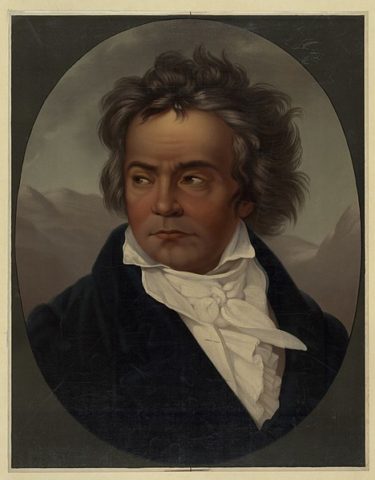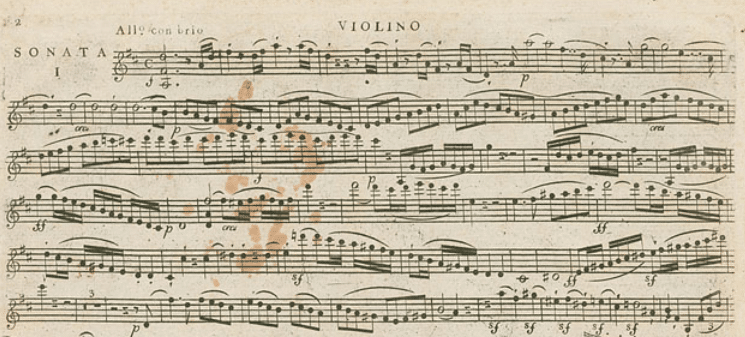 Ludwig van Beethoven (1770-1827) is undoubtedly one of the most celebrated composers in history, often thought of as a musical genius. But Beethoven also possessed a brooding affect and grappled with years of emotional, physical, and substance abuse problems. Straddling the transition from the Classical Period to the Romantic Period, his mature works dramatically challenged the elegance, symmetry, and simplicity of the Classical Period, resulting in musical innovations in form, rhythmic usage, harmonic structure, and emotional content.
Ludwig van Beethoven (1770-1827) is undoubtedly one of the most celebrated composers in history, often thought of as a musical genius. But Beethoven also possessed a brooding affect and grappled with years of emotional, physical, and substance abuse problems. Straddling the transition from the Classical Period to the Romantic Period, his mature works dramatically challenged the elegance, symmetry, and simplicity of the Classical Period, resulting in musical innovations in form, rhythmic usage, harmonic structure, and emotional content.
Beethoven’s life was a series of ongoing struggles, which surely informed the character of his compositions. His childhood was difficult, primarily due to his father’s obsession with developing Beethoven into a child prodigy similar to Mozart. Unfortunately, in the case of Beethoven, his training – in keyboard instruments, violin, viola, theory, and composition – was intense and dysfunctional. His alcoholic father treated him brutally, both emotionally and likely physically, often bringing him to tears.
His adult life was also plagued with illness and at times poverty and legal difficulties, including battles over his father’s pension, custody of a nephew, issues obtaining work, and family problems. His illnesses include his well-known deafness, which was a form of progressive hearing loss occurring over more than twenty years, as well as a period of what he called “inflammatory fever,” liver problems (likely in part due to alcohol), jaundice, fever, and other serious symptoms. Beethoven became progressively more withdrawn as he aged, and his compositional output was interrupted at times for years due to his emotional, physical, family, and legal problems.
For the past century, it has been argued that Beethoven may have had African or what was then called “Moorish” ancestry, as he was frequently described as dark in complexion with pronounced features. The evidence on this theory is mixed, as his official genealogy is Flemish. Whether true or not, it was not acknowledged by Beethoven, though he did work with several “Moorish” or mixed race musicians, including violinist George Bridgetower.
Beethoven’s Music
Most players of orchestral instruments will encounter Beethoven’s music through his orchestral and chamber music, as he wrote few concertos or sonatas for instruments other than the piano or violin. His orchestral output includes nine symphonies, as well as numerous overtures and other forms of incidental music. His chamber music comprises a series of string quartets, ten violin sonatas, a handful of cello sonatas, piano trios and quartets, and chamber music for winds. Writing most extensively for the piano, his repertoire for that instrument includes sonatas, concertos, and other incidental pieces. He also composed numerous pieces for voice or choir, including several large-scale religious works, one complete opera, and numerous songs.
Beethoven’s Compositional Development
As Beethoven was a transitional composer, his style changed considerably over his lifetime. Most musicologists divide his output into three mature periods. His early period, reflective of his compositional studies with Haydn and others of the time, lasted until the turn of the century and includes works that are more reminiscent of the Classical era. These early works demonstrate a mastery of the genres and style of this earlier period.
Sonata No. 1 for Violin and Piano (1798), an example of an early work in a more Classical style

His middle period, spanning from roughly 1802-16, was his period of innovation, and was often called “heroic” for its portrayal of the heroic struggle of humankind. During this time, he composed most of his symphonies, his opera Fidelio, the Razumovsky collection of string quartets, and some of his most famous piano sonatas and concertos. These pieces tend to show innovations in form, such as extended development sections that pass through different keys and transform motives. They are overall more emotionally laden and darker in character than his earlier works, and often have extra-musical references and a wider range of dramatic content.
A more introspective and experimental character marked his final period, from roughly 1816 until his death, often called his transcendent years. Some of his greatest works, including the Ninth Symphony and his Missa solemnis, as well as some of his more technically challenging string quartets and piano sonatas, were written during this time. He experimented with variation, improvisation, contrapuntal forms, large-scale forms, dynamics, and tempo.
String Quartet op. 131 (1826), demonstrating a later style, complete with slower tempo, chromaticism, contrapuntal texture, and dramatic content and dynamics.

Performing Beethoven
When approaching Beethoven, a performer must first identify where the piece of music falls during Beethoven’s lifetime. For example, compositions from his early period need to be played in a much more rhythmically and dynamically straightforward style, while pieces from his middle period can be more dramatic, with a wider range of tempi, rubato, and dynamics. Knowing what was happening in his life at the time of composition can also help determine how a piece should be played, as he often portrayed his emotional characteristics in his music.
Scholarly editions or urtexts are a must for performing Beethoven, as his dynamics, tempo markings, articulations, and bowings were deliberate and intentional. Modern editions often muddy these original intentions.
For violinists and violists, the later years of Beethoven marked a dramatic change in playing technique due to two new additions: the chinrest and a more modernized Tourte bow. The combination of these changes allowed for much greater use of shifting and vibrato, as well as complex bow techniques. The new bows also allowed for a more sustained, singing legato to the sound. Nonetheless, most Beethoven orchestral works, especially the earlier ones, would have been performed with little vibrato, reserving vibrato only for ornamentation. Portamento, or sliding between positions, also became more common, though there were mixed opinions at the time over the use of this technique. Strings during this time were still made of gut, giving open strings a warmer and rounder sound, meaning open strings were used much more commonly.
Wind instruments of the time were mostly in transition. During Beethoven’s life, the wooden flute remained the norm, but oboes, clarinets, and bassoons were transforming from instruments with just a few keys to more modern versions, such as the 13-key oboe, the 12-key bassoon, and the 13-key clarinet. Brass instruments remained primarily “natural,” meaning they had no valves and pitch was changed by the embouchure or hand-stopping.
The use of rubato and tempo fluctuation also changed during the time of Beethoven. In both the Baroque and Classical periods, a consistent steady tempo was always the norm. While many early movements in the time of Beethoven still retain the rhythmic constancy of previous eras, composers and players began to progressively include more rubato into works, a practice that grew even further in the decades after Beethoven’s death.
Enjoy Beethoven!
Enjoy these performances of Beethoven by CMPI students.
Images
Top: An image of Beethoven; an early copy of Beethoven’s Sonata No. 1 for piano and violin; an early copy of String Quartet op. 131.